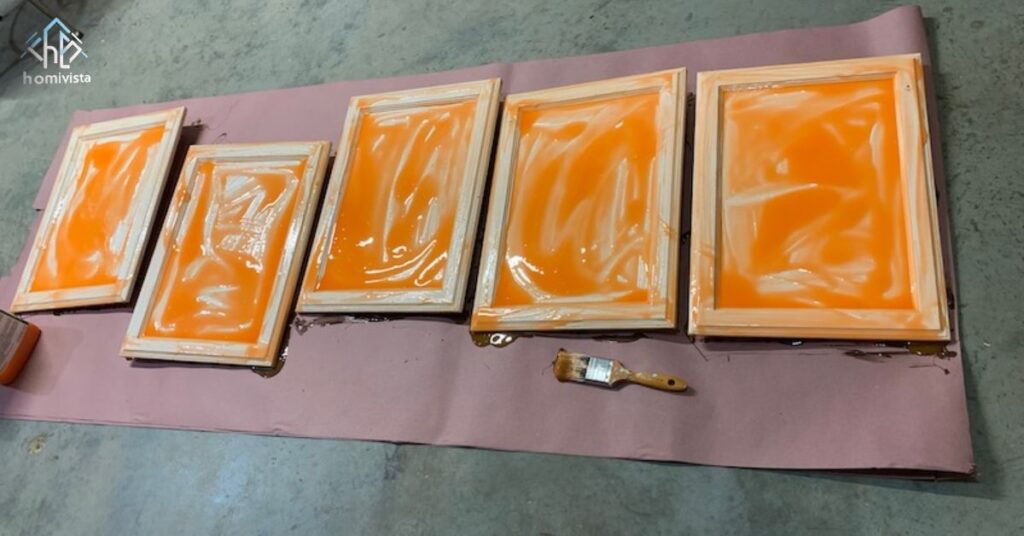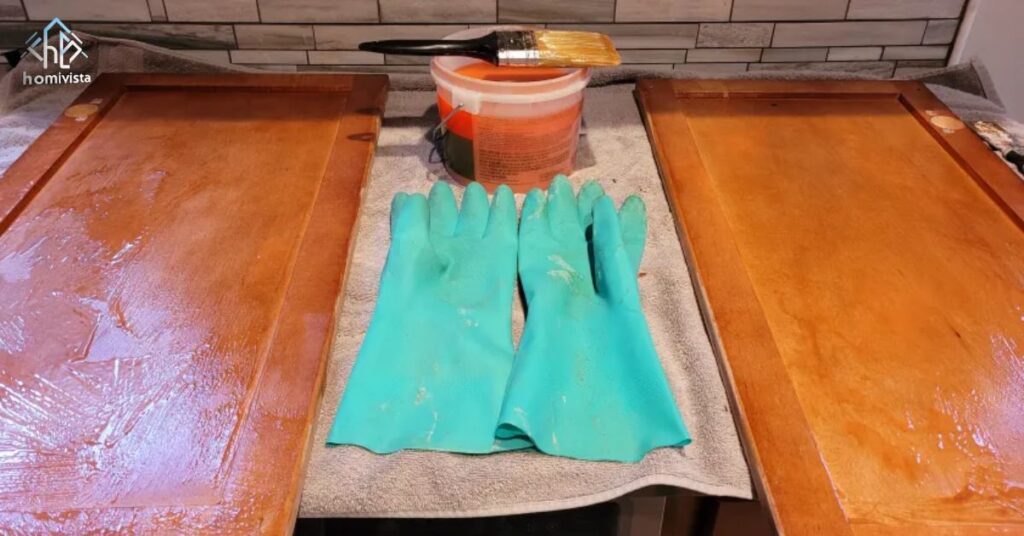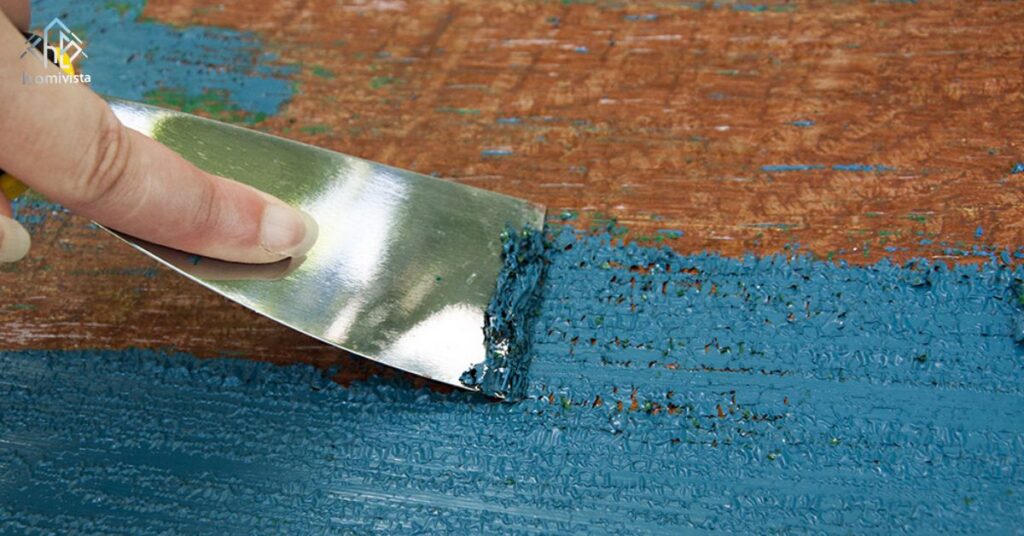Removing paint from cabinets is straightforward. Paint stripper, scraper, sandpaper, gloves, and safety goggles. Protect your workspace with a drop cloth. Apply the paint stripper to the cabinet surface.
Wait for the recommended time, usually 15-30 minutes. Scrape off the softened paint gently. Use sandpaper to remove any remaining paint. Clean the cabinets with a damp cloth. Let them dry completely. Your cabinets are now ready for refinishing or repainting.
Pro Tips for Stripping Paint From Cabinets: A How-to Guide
When you are ready to start, apply the paint stripper generously to the cabinet surface and let it sit according to the manufacturer instructions.Use a putty knife to gently scrape away the softened paint.
Take your time and work in small sections to ensure thorough removal. Clean the cabinets with soap and water to remove any residue and reveal the natural beauty underneath.
Read More: What To Put In Glass Kitchen Cabinets
Do You Need to Strip the Paint from Your Cabinets?
Taking off paint from cabinets can be tricky but with the right tips, it’s manageable. Gathering all your tools and materials. Then, prepare your workspace by covering nearby surfaces and ensuring good ventilation.

Use a chemical paint stripper or a heat gun to soften the paint. Apply the stripper or heat carefully and evenly. Once the paint softens, use a scraper to gently remove it from the cabinets.
Clean the cabinets thoroughly to remove any residue. The surface for a smooth finish and apply a fresh coat of paint or sealant to protect the wood. With patience and attention to detail your cabinets will look brand new.
What if the cabinet paint is stained, but not cracked or flaking?
cabinets have tannin stains in the paint but are not showing signs of paint failure, stripping might not be required. Tannin staining occurs when wood oils bleed into the paint, causing visible marks known as tannin bleed through.
This issue typically arises when the wood is not properly primed or when the wrong primer is used. In such cases, stripping the paint is not necessary as long as the existing paint remains intact. You can address this by washing the cabinets, applying a quality stain blocking sealer as a primer and then painting over them.
What about sanding instead of stripping the paint?
Sanding the wood with coarse sandpaper will remove some of the paint, but it takes much longer than using a chemical stripper. Aggressive sanding can also damage the profile of cabinet doors.
Light sanding at the end is beneficial. It helps remove any remaining old paint from the surface after most of the paint layers have been stripped away with chemicals.
20 Mistakes to Avoid When Painting Kitchen Cabinets
Skipping the Prep Work
- Not cleaning or sanding cabinets before painting.
Using the Wrong Paint
- Choosing non-durable or incorrect paint types.
Ignoring Primer
- Skipping the primer, which is essential for adhesion.
Not Removing Hardware
- Painting over hinges and knobs instead of removing them.
Failing to Label Doors and Drawers
- Not labeling parts, leading to confusion during reassembly.
Overlooking Tannin Stains
- Not addressing tannin stains, causing bleed-through.
Using a Single Coat
- Applying only one coat, resulting in poor coverage.
Rushing the Drying Process
- Not allowing enough time for each coat to dry properly.
Painting in Poor Lighting
- Working in dim lighting, leading to missed spots.
Neglecting Safety Measures
- Ignoring ventilation and protective gear.
Using Cheap Brushes and Rollers
- Opting for low-quality tools, leading to a poor finish.
Not Sanding Between Coats
- Skipping the light sanding needed for smooth layers.
Applying Thick Layers
- Using thick coats, which can cause drips and uneven texture.
Ignoring Temperature and Humidity
- Painting in unsuitable conditions affecting the finish.
Not Protecting Surrounding Areas
- Failing to cover floors and countertops, causing unwanted paint splatters.
Skipping Deglossing
- Not deglossing glossy surfaces, hindering paint adhesion.
Incorrect Brush Technique
- Using poor brushing techniques, leaving visible strokes.
Reassembling Too Soon
- Putting cabinets back together before the paint cures.
Not Using a Topcoat
- Failing to apply a protective topcoat for durability.
How to Strip Paint From Cabinets

1. Gather Tools and Materials
- Tools: Paint stripper, plastic drop cloths, painter’s tape, rubber gloves, safety goggles, respirator mask, scrapers or putty knives, steel wool or abrasive pads, sandpaper (various grits), brushes.
- Materials: Mineral spirits or paint thinner, clean cloths, plastic containers for waste disposal.
2. Prepare Your Workspace
- Lay down plastic drop cloths to protect floors and countertops.
- Use painter’s tape to cover areas that should not be stripped.
- Ensure the area is well-ventilated by opening windows or using fans.
3. Remove Cabinet Hardware
- Unscrew and remove all handles, knobs, and hinges from the cabinets.
- Label each piece of hardware and its corresponding location to facilitate reassembly.
4. Apply Paint Stripper
- Wear rubber gloves, safety goggles, and a respirator mask.
- Use a brush to apply a generous layer of paint stripper to the painted surfaces of the cabinets.
- Follow the manufacturer’s instructions for the amount of stripper to use and the recommended wait time (typically 15-30 minutes).
5. Scrape Off the Paint
- Once the paint starts to bubble and soften, use a scraper or putty knife to gently remove the paint.
- Be careful not to gouge or damage the wood underneath.
6. Use Steel Wool or Abrasive Pad
- For intricate areas and stubborn paint spots, use steel wool or an abrasive pad dipped in paint stripper.
- Work in small sections to ensure thorough removal.
7. Clean the Surface
- After removing the paint, wipe down the cabinets with a cloth dampened with mineral spirits or paint thinner to remove any remaining residue and neutralize the stripper.
- Allow the cabinets to dry completely.
8. Sand the Cabinets
- Sand the entire surface of the cabinets with medium-grit sandpaper to smooth out any rough spots and remove any remaining paint traces.
- Follow with fine-grit sandpaper for a smooth finish.
- Wipe off the sanding dust with a clean, damp cloth.
9. Clean Up
- Properly dispose of used paint stripper, paint residue, and cleaning materials according to local hazardous waste disposal regulations.
- Clean your tools with appropriate solvents and store them safely.
10. Final Inspection
- Examine the cabinets for any remaining paint or rough spots.
- Reapply paint stripper and repeat the process if necessary for any missed areas.
- Ensure the cabinets are clean, dry, and smooth, ready for priming and painting.
Following these steps you can effectively strip paint from your cabinets, leaving them ready for a new finish.
Frequently Asked Questions
What tools and safety gear are needed for stripping paint from cabinets?
Tools: Paint stripper, scrapers or putty knives, steel wool or abrasive pads, sandpaper, brushes. Safety gear: Rubber gloves, safety goggles, respirator mask.
How should you prepare your workspace before starting the paint stripping process?
Lay down plastic drop cloths, use painter’s tape to cover areas not being stripped, ensure good ventilation.
What is the purpose of using mineral spirits or paint thinner after scraping off paint?
Clean the surface, remove remaining paint residue, and neutralize the effects of the paint stripper.
Why is it important to sand the cabinets after removing the paint?
Smooth out rough spots, prepare surface for primer and paint, ensure better adhesion, and remove any remaining traces of paint or residue.
Conclusion
Stripping paint from cabinets necessitates the right tools, proper preparation, and safety precautions. By utilizing paint stripper, scrapers and sandpaper alongside safety gear you can efficiently remove old paint.
Adequate workspace preparation minimizes mess and exposure to fumes. Additionally, using mineral spirits or paint thinner post stripping cleans the surface for refinishing. Sanding ensures a smooth surface for primer and paint application. With these steps, achieving a refreshed cabinet appearance is achievable.







